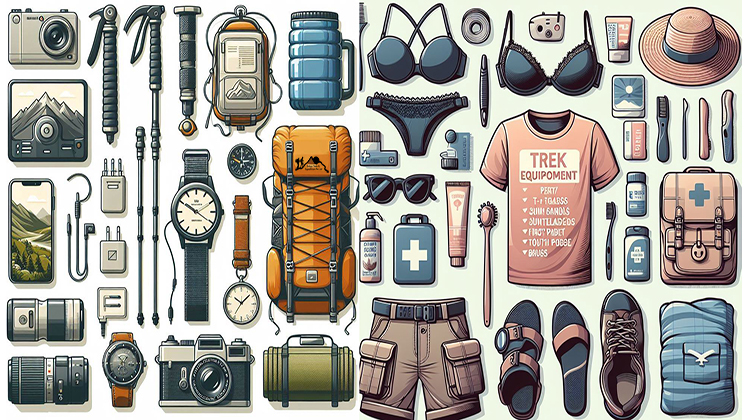
Trekking equipment information.
Prepare for your mountain trek with our trekking equipment checklist. This guide will help you pack efficiently for any of our trips. Remember, minimizing the weight of your clothing and gear is crucial to meet the luggage policy. Selecting the right gear depends on factors like the destination, trek duration, season, altitude, and the local environment. Review the sample checklist below. You don’t need to bring everything listed—use your judgment and past experience to make the best choices for your trek.
Drinking Water:
A bottle of water is essential for staying hydrated. In warm conditions, drink one liter per hour, while in cooler weather, two cups per hour may suffice. At high altitudes or in extreme heat, intake doubles to one liter every hour. Always ask your guide about refill points on the trail. On long hikes without water sources, carry at least two liters, adding 1 to 2 kilograms to your pack. Popular trails often have easy access to drinking water.
First Aid/Medical Kit:
A Dettol/Savlon, crepe bandage, cotton, antiseptic creme, a course for each including pain killer, headache, vomiting, anti-inflammatory, and stomach upset, Volini spray. Together all these weigh again a maximum of 500 grams.
Maintain some dry instant edible food items for emergencies. A pack of candy, a few chocolate bars, energy bars, a dry fruit mix, and a small pack of Glucon C/D/Gatorade. Altogether about 600 grams.
Take some Diamox Tablets. Acetazolamide is used to prevent and reduce the symptoms of altitude sickness. This medication can decrease headaches, tiredness, nausea, dizziness, and shortness of breath that can occur when you climb quickly to high altitudes (generally above 10,000 feet/3,048 meters). You can get altitude sickness if you travel to a high altitude too quickly.
Sleeping Bags:
When trekking in the Himalayas, a warm sleeping bag is essential. Choose one rated between -10°C to 0°C to stay comfortable in freezing mountain nights. A duck or goose down sleeping bag is highly recommended for superior warmth, though pricier. Budget travelers can opt for synthetic sleeping bags, which weigh around 2 kg. For extra warmth in lower temperatures, layering with an additional base inside the bag helps retain heat.
Trekking and Hiking Shoes:
For trekking in the Himalayas, sturdy and well insulated hiking boots are essential. Choose waterproof, ankle supporting boots with a strong grip for rocky, uneven, and sometimes icy trails. Branded shoes are not mandatory, but premium quality trekking boots from trusted brands offer better durability, comfort, and protection.
If choosing budget-friendly alternatives, break them in well before the trek to avoid blisters. For high altitude or winter treks, choosing for insulated boots with strong traction to withstand extreme cold and snow.
Best Hiking Socks:
Crew length socks are ideal for trekking, as they prevent high boots from rubbing against your ankles. For lower top shoes, opt for shorter socks that sit above the cuff to keep your feet cooler. If heading for a base camp trek, pack 2 to 3 pairs of high quality hiking socks for comfort and durability.
Using the Gaiters:
Gaiters are essential for keeping your feet warm and dry on wet or snowy trails. Alpine style gaiters secure to bootlaces and stay in place with a strap under the instep, making them ideal for most trekking conditions. They are highly useful and widely available in Kathmandu’s gear shops.
Luggage on Trekking:
A rucksack is essential for trekking, as porters carry the main packs. Even if you bring a suitcase for Nepal, Bhutan, or Tibet, a proper backpack (Rucksack) is necessary for the trek. Keep your packed bag under 12 kg (26.5 lbs) to ensure safe porter loads. Avoid unnecessary items or gear easily available on the trail. Leave home keys, heavy clothes, jewelry, and single use gear at your hotel or with the Gokyo Treks agency. You can collect them upon returning to Kathmandu.
Check the luggage Policy:
When hiking in the Himalayas, it’s important to be aware of baggage allowances. Many airlines charge extra for overweight bags. For flights from Kathmandu to Pokhara, you’re allowed 25 kg (55 lbs), while flights to Jomsom, Lukla, Rara, Tumlingtar, Sukilumba, and Dolpa permit 15 kg (33 lbs). If using porters, each can carry a maximum of 24 kg (52.8 lbs). If your backpack exceeds 12 kg (26.4 lbs), an additional fee of US$1 will apply, paid directly to your porter.
Hand carry policy:
For added security, keep valuables such as your passport, wallet, and expensive jewelry in a lightweight daypack. When traveling in Nepal, consider leaving your important items, like your ID and keys, at the Gokyo Treks agency office. During your trek, carry a small daypack to hold essentials like a water bottle, first aid kit, camera batteries, and other personal items.
Suggested key equipment or trekking pack List for trekking in the Nepal Himalayas.
| For Low and Moderate Altitude Trekking | |
|
|
For Higher Altitude Trekking (Above 4000m) |
|
|
|
Peak Climbing and Expedition Equipment checklist key things |
|
|
|
